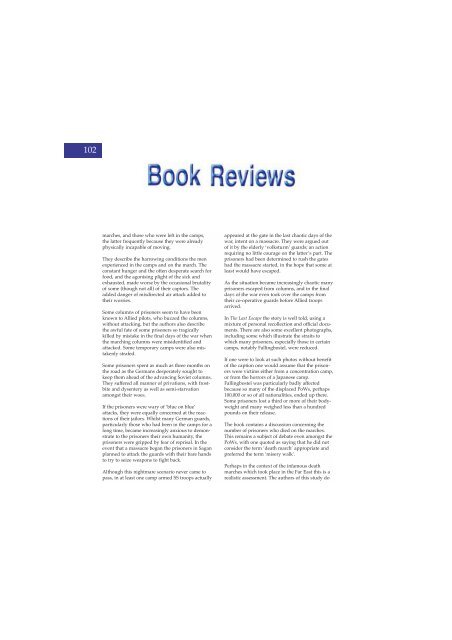Volume 6 No 4 - Royal Air Force Centre for Air Power Studies
Volume 6 No 4 - Royal Air Force Centre for Air Power Studies
Volume 6 No 4 - Royal Air Force Centre for Air Power Studies
You also want an ePaper? Increase the reach of your titles
YUMPU automatically turns print PDFs into web optimized ePapers that Google loves.
102<br />
marches, and those who were left in the camps,<br />
the latter frequently because they were already<br />
physically incapable of moving.<br />
They describe the harrowing conditions the men<br />
experienced in the camps and on the march. The<br />
constant hunger and the often desperate search <strong>for</strong><br />
food, and the agonising plight of the sick and<br />
exhausted, made worse by the occasional brutality<br />
of some (though not all) of their captors. The<br />
added danger of misdirected air attack added to<br />
their worries.<br />
Some columns of prisoners seem to have been<br />
known to Allied pilots, who buzzed the columns,<br />
without attacking, but the authors also describe<br />
the awful fate of some prisoners so tragically<br />
killed by mistake in the final days of the war when<br />
the marching columns were misidentified and<br />
attacked. Some temporary camps were also mistakenly<br />
strafed.<br />
Some prisoners spent as much as three months on<br />
the road as the Germans desperately sought to<br />
keep them ahead of the advancing Soviet columns.<br />
They suffered all manner of privations, with frostbite<br />
and dysentery as well as semi-starvation<br />
amongst their woes.<br />
If the prisoners were wary of ‘blue on blue’<br />
attacks, they were equally concerned at the reactions<br />
of their jailors. Whilst many German guards,<br />
particularly those who had been in the camps <strong>for</strong> a<br />
long time, became increasingly anxious to demonstrate<br />
to the prisoners their own humanity, the<br />
prisoners were gripped by fear of reprisal. In the<br />
event that a massacre began the prisoners in Sagan<br />
planned to attack the guards with their bare hands<br />
to try to seize weapons to fight back.<br />
Although this nightmare scenario never came to<br />
pass, in at least one camp armed SS troops actually<br />
appeared at the gate in the last chaotic days of the<br />
war, intent on a massacre. They were argued out<br />
of it by the elderly ‘volksturm’ guards; an action<br />
requiring no little courage on the latter’s part. The<br />
prisoners had been determined to rush the gates<br />
had the massacre started, in the hope that some at<br />
least would have escaped.<br />
As the situation became increasingly chaotic many<br />
prisoners escaped from columns, and in the final<br />
days of the war even took over the camps from<br />
their co-operative guards be<strong>for</strong>e Allied troops<br />
arrived.<br />
In The Last Escape the story is well told, using a<br />
mixture of personal recollection and official documents.<br />
There are also some excellent photographs,<br />
including some which illustrate the straits to<br />
which many prisoners, especially those in certain<br />
camps, notably Fallingbostel, were reduced.<br />
If one were to look at such photos without benefit<br />
of the caption one would assume that the prisoners<br />
were victims either from a concentration camp,<br />
or from the horrors of a Japanese camp.<br />
Fallingbostel was particularly badly affected<br />
because so many of the displaced PoWs, perhaps<br />
100,000 or so of all nationalities, ended up there.<br />
Some prisoners lost a third or more of their bodyweight<br />
and many weighed less than a hundred<br />
pounds on their release.<br />
The book contains a discussion concerning the<br />
number of prisoners who died on the marches.<br />
This remains a subject of debate even amongst the<br />
PoWs, with one quoted as saying that he did not<br />
consider the term ‘death march’ appropriate and<br />
preferred the term ‘misery walk’.<br />
Perhaps in the context of the infamous death<br />
marches which took place in the Far East this is a<br />
realistic assessment. The authors of this study do
















